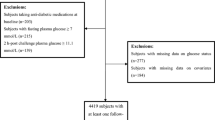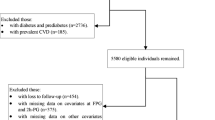Abstract
Objective: To investigate the correlation between abnormal oral glucose tolerance test (OGTT) 30-min plasma glucose (PG) and risk factors and metabolic abnormalities of diabetes and cardiovascular diseases (CVD). Methods: Participants (no.=2457) underwent a physical examination, blood biochemistry examination, OGTT, and a 12-lead electrocardiogram. We measured fasting PG (FPG) and PG at 30 min (30minPG) and 1 h (1hPG) of the OGTT. The association between an increase in 30minPG (by 1 SD) and the metabolic abnormalities of diabetes and CVD such as hypertension, overweight and obesity, central obesity, and hyperlipidemia; osteoporosis was assessed by logistic regression analysis after controlling for FPG and 2hPG. Results: This analysis showed that an increase of 30minPG by 1 SD (1.92 mmol/l) significantly increased the risk of chronic metabolic abnormalities in diabetes and CVD such as hypertension, overweight, and obesity, central obesity, hyperlipidemia, and osteoporosis. Stepwise multiple regression analysis also showed that 30minPG was significantly correlated with male gender, smoking, FPG, 2hPG, total cholesterol, waist/hip ratio, and blood pressure. Conclusions: An elevation of 30minPG increased the risk of diabetes and CVD. The increased risk was independent of FPG, 2hPG, age, sex, and smoking status.
Similar content being viewed by others
References
Coutinho M, Gerstein HC, Wang Y, Yusuf S. The relationship between glucose and incident cardiovascular events. A metaregression analysis of published data from 20 studies of 95,783 individuals followed for 12.4 years. Diabetes Care 1999, 22: 233–40.
Meigs JB, Nathan DM, D’Agostino RB Sr, Wilson PW; Framingham Offspring Study. Fasting and postchallenge glycemia and cardiovascular disease risk: the Framingham offspring study. Diabetes Care 2002, 25: 1845–50.
DECODE Study Group, the European Diabetes Epidemiology Group. Glucose tolerance and cardiovascular mortality: comparison of fasting and 2-hour diagnostic criteria. Arch Intern Med 2001, 161: 397–405.
Fuchigami M, Nakano H, Oba K, Metori S. Oral glucose tolerance test using a continuous blood sampling technique for analysis of the blood glucose curve. Nippon Ronen Igakkai Zasshi 1994, 31: 518–24.
Cohen O, Basu R, Bock G, et al. Prediction of postprandial glycemic exposure. Utility of fasting and 2-h glucose measurements alone and in combination with assessment of body composition, fitness, and strength. Diabetes Care 2006, 29: 2708–13.
Orencia AJ, Daviglus ML, Dyer AR, Walsh M, Greenland P, Stamler J. One-hour postload plasma glucose and risks of fatal coronary heart disease and stroke among nondiabetic men and women: The Chicago Heart Association Detection Project in Industry (CHA) Study. J Clin Epidemiol 1997, 50: 1369–76.
Liu K, Dyer AR, Vu TH, et al. One-hour postload plasma glucose in middle age among nondiabetic men and women: The Chicago Heart Association Detection Project in Industry. Diabetes Care 2005, 28: 1057–62.
Abdul-Ghani MA, Abdul-Ghani T, Ali N, Defronzo RA. One-hour plasma glucose concentration and the metabolic syndrome identify subjects at high risk for future type 2 diabetes. Diabetes Care 2008, 31: 1650–5.
Viswanathan V, Clementina M, Nair BM, Satyavani K. Risk of future diabetes is as high with abnormal intermediate post-glucose response as with impaired glucose tolerance. J Assoc Physicians India 2007, 55: 833–7.
Harada N, Fukushima M, Toyoda K, et al. Factors responsible for elevation of 1-h postchallenge plasma glucose levels in Japanese men. Diabetes Res Clin Pract 2008, 81: 284–9.
Matsuda M, Defronzo RA. Insulin sensitivity indices obtained from oral glucose tolerance testing: comparison with the euroglycemic insulin clamp. Diabetes Care 1999, 22: 1462–70.
Friedewald WT, Levy RI, Fredrickson DS. Estimation of the concentration of low-density lipoprotein cholesterol in plasma without use of the preparative ultracentrifuge. Clin Chem 1972, 18: 499–502.
Kung AW, Ho AY, Ross PD, Reginster JY. Development of a clinical assessment tool in identifying Asian men with low bone mineral density and comparison of its usefulness to quantitative bone ultrasound. Osteoporos Int 2005, 16: 849–55.
Li-Yu JT, Llamado U, Torralba TP. Validation of OSTA among Filipinos. Osteoporos Int 2005, 16: 1789–93.
Hanson RL, Imperatore G, Bennett PH, Knowler WC. Components of the ‘metabolic syndrome’ and incidence of type 2 diabetes. Diabetes 2002, 51: 3120–7.
Isomaa B, Almgren P, Tuomi T, et al. Cardiovascular morbidity and mortality associated with the metabolic syndrome. Diabetes Care 2001, 24: 683–9.
Brown SA, Sharpless JL. Osteoporosis: an under-appreciated complication of diabetes. Clin Diabetes 2004, 22: 10–20.
Nawroth P, Pirzer R, Fohr B, et al. Osteoporosis and cardiovascular disease—two sides of the same coin? Med Klin (Munich) 2003, 8: 437–46.
Kadowaki S, Okamura T, Hozawa A, et al; NIPPON DATA Research Group. Relationship of elevated casual blood glucose level with coronary heart disease, cardiovascular disease and all-cause mortality in a representative sample of the Japanese population. NIPPON DATA80. Diabetologia 2008, 51: 575–82.
Stevens RJ, Coleman RL, Adler AI, Stratton IM, Matthews DR, Holman RR. Risk factors for myocardial infarction case fatality and stroke case fatality in type 2 diabetes: UKPDS 66. Diabetes Care 2004, 27: 201–7.
Risso A, Mercuri F, Quagliaro L, Damante G, Ceriello A. Intermittent high glucose enhances apoptosis in human umbilical vein endothelial cells in culture. Am J Physiol Endocrinol Metab 2001, 5: 924–30.
The Diabetes Control and Complications Trial Research Group. The effect of intensive treatment of diabetes on the development and progression of long-term complications in insulin-dependent diabetes mellitus. N Engl J Med 1993, 30: 977–86.
Fujimoto K, Hozumi T, Watanabe H, et al. Acute hyperglycemia induced by oral glucose loading suppresses coronary microcirculation on transthoracic Doppler echocardiography in healthy young adults. Echocardiography 2006, 23: 829–34.
Weyer C, Tataranni PA, Bogardus C, Pratley RE. Insulin resistance and insulin secretory dysfunction are independent predictors of worsening of glucose tolerance during each stage of type 2 diabetes development. Diabetes care 2001, 24: 89–94.
Bunt JC, Krakoff J, Ortega E, Knowler WC, Bogardus C. Acute insulin response is an independent predictor of type 2 diabetes mellitus in individuals with both normal fasting and 2-h plasma glucose concentrations. Diabetes Metab Res Rev 2007, 23: 304–10.
Abdul-Ghani MA, Williams K, Defronzo RA, Stern M. What is the best predictor of future Type 2 diabetes? Diabetes Care 2007, 30: 1544–8.
Zhou W, Gu Y, Li H, Luo M. Assessing 1-h plasma glucose and the shape of the glucose curve during oral glucose tolerance test. European Journal of Endocrinology 2006, 155: 191–7.
Author information
Authors and Affiliations
Corresponding author
Additional information
These authors equally contributed to the study.
Rights and permissions
About this article
Cite this article
Chen, G., Zou, X., Yao, J. et al. The correlation between the oral glucose tolerance test 30-minutes plasma glucose and risk factors for diabetes and cardiovascular diseases: A cross-sectional epidemiological study of diabetes in Fujian Province in the South-East of China. J Endocrinol Invest 34, e115–e120 (2011). https://doi.org/10.1007/BF03347470
Accepted:
Published:
Issue Date:
DOI: https://doi.org/10.1007/BF03347470




